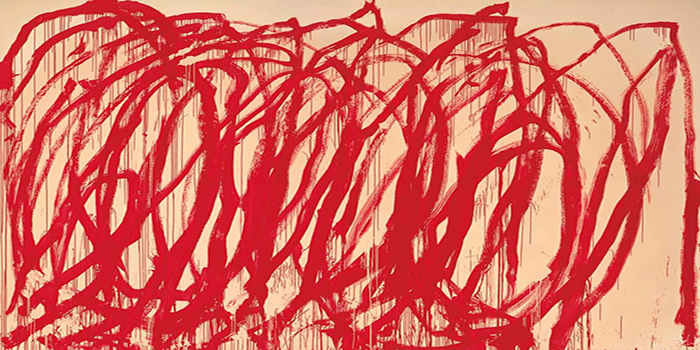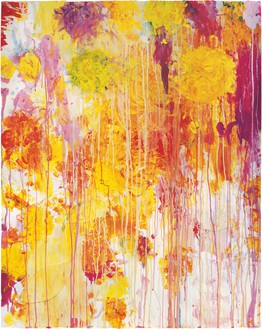CY TWOMBLY
Feb 24th 2021
You know you have a big name when you're featured in The Simpsons. The insanely popular TV show has had cameo appearances as notable as Leonard Nimoy, Michael Jackson, Johnny Cash, Stephen Hawking, to name a few.
And as iconic as the show itself, is the opening sequence showing Bart Simpson writing on the chalkboards. Again, this has been used to reference many events or jokes pertinent to the time it was aired. It was recently, when, as one of the show's fun mashups with fine Art, the blackboard was replaced with the Cy Twombly´s "Untitled" artwork, creating all sorts of reactions –whether positive or negative, no one can deny the geniality behind our favorite yellow characters.

The fact that Cy Twombly made his footprint in the show has a dual meaning. The first one, that his name is renowned enough to be featured –no point in including a character no one would recognize. The second one is the inherent link between Twombly and kids, perhaps because his work is the epitome of what skeptics keep saying when they are befuddled by the absurdity behind Art: "My kid could've done that." In any case, if a kid would've done that, he would've made his or her parents $70.5 million richer –which is the price at which the painting sold. We're sure of one thing, Bart would have made Homer real happy.
In all seriousness –if that can be attempted after discussing the Simpsons –what was behind Cy Twombly's paintings? Was he scribbling? Is it just graffiti elevated to a reserved category that harbors only great artists?
"Graffiti is usually a protest - ink on walls - or has a reason for being naughty or aggressive."
Cy Twombly.

Edwin Parker "Cy" Twombly was born on April 25, 1928, in Lexington, Virginia. His father –also named "Cy," was a pitcher of the Chicago White Sox. Actually, both were named after the great Cy Young, who pitched for several MLB teams. Aside from being a painter, Cy Twombly was a photographer and a sculptor.
His artwork can be described as calligraphic, capriciously-scribbled, large-scale graffiti-like works. He preferred using solid fields on off-white, gray, or tan colors. The only way to describe Twombly is by acknowledging he had a "cultural memory." All of his paintings and the rest of the artwork come from a place within his past experiences, mixed with his own interpretations of literature and past years' visual arts.
However, it was necessary for Kirk Varnedoe –the American art historian –to defend Cy Twombly's wild splashes and marks against the harsh criticism that proclaimed that "any kid could do it." He even wrote an essay on the subject, which can be found at MoMA.
Saying that any kid could scribble like Twombly would be like stating that any child painting squares could emulate Picasso, or saying that any kid with a hammer and chisel could produce a Michelangelo's David.
Connoisseurs say that the brilliancy of Art resides not so much on the individual mark but in the set of "personal rules" each artist has and the careful orchestration of a process that ends up in an art piece. In other words, we may perceive freedom, randomness, and disorder in a painting, but behind each stroke, and brush, we must sense a carefully performed movement. Moreover, chaos before our eyes, the picture had to "be ready" at one point, where his creator decided it was time to stop –which is easier said than done when creating Art in any shape or form. There's a beauty that can only be achieved by imperfection and the sense of an "almost" completion.
If you have children, have been around them, or have memories of yourself painting and drawing at a young age, you can relate to Twombly. When our child proudly displays his or her drawing before us, we may notice the shapes are crooked, or the colors don't make sense. Or maybe, we only see random scribbles over the piece of paper. But behind it, there was a thought process and images that traveled from someone's little brain all the way to a hand that transmitted such emotion. It is not that the cloud your child draw is wrong because that's precisely how she or he perceives it.
No artist –not even Cy Twombly –should be ashamed or annoyed if someone compares them with children. In fact, if you'd try to emulate a kid's painting, you would find it quite challenging, as it is hard to copy someone's emotions –even if these are depicted as stick figures made with crayons.
"My line is childlike but not childish. It is very difficult to fake…to get that quality; you need to project yourself into the child's line. It has to be felt." Cy Twombly
Another link between Twombly and children is that he took pleasure in his work per se. A famous quote of him was: "I swear if I had to do this over again, I would just do the paintings and never show them." Children are the same; they create not to show off and certainly not to profit. They make for the pure pleasure that produces in them; Cy Twombly understood this well.
Nonetheless, art experts are correct. No child can emulate Twombly's Art simply because they are not him. Whatever figure, emotion, event is hidden between such scribbles speaks to the viewer. And for reasons beyond our understanding, that random picture, with splotches, and fluid lines, can make us feel uncomfortable, happy, serene, afraid, or angry. That's the beauty of Art –it should require no explanation.

